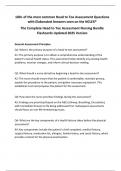100+ of the most common Head to Toe Assessment Questions
with Elaborated Answers seen on the NCLEX®
The Complete Head to Toe Assessment Nursing Bundle
Flashcards Updated 2025 Version
General Assessment Principles
Q1: What is the primary purpose of a head-to-toe assessment?
A1: The primary purpose is to obtain a comprehensive understanding of the
patient's overall health status. This assessment helps identify any existing health
problems, monitor changes, and inform clinical decision-making.
Q2: What should a nurse do before beginning a head-to-toe assessment?
A2: The nurse should ensure that the patient is comfortable, maintain privacy,
explain the procedure to the patient, and gather necessary equipment. This
establishes trust and prepares the patient for the assessment.
Q3: How does the nurse prioritize findings during the assessment?
A3: Findings are prioritized based on the ABCs (Airway, Breathing, Circulation),
with immediate threats to life being addressed first. Subsequent assessments
should focus on non-life-threatening issues.
Q4: What are the key components of a health history taken before the physical
assessment?
A4: Key components include the patient's chief complaint, medical history,
surgical history, medication list, allergies, family history, and social history, which
provides context for the physical examination.
,Q5: Why is documentation important after a head-to-toe assessment?
A5: Documentation ensures that findings are accurately recorded for future
reference, facilitates communication among healthcare team members, and
provides a legal record of the patient's condition.
Head Assessment
Q6: What are some common abnormalities to look for in the head during
assessment?
A6: Common abnormalities include asymmetry, lesions, and tenderness. Hair
distribution and scalp condition (e.g., dryness, flakiness) should also be noted.
Q7: How should the nurse assess the patient's eyes?
A7: The nurse should check visual acuity using a Snellen chart, inspect for pupil
size and reaction to light (PERRLA), and assess for any redness, discharge, or
abnormalities in eye structure.
Q8: What does a fundoscopic exam reveal?
A8: A fundoscopic exam allows the nurse to visualize the retina, optic disc, and
blood vessels, helping to identify conditions such as hypertension, diabetes, or
optic nerve disorders.
Q9: What is the significance of assessing the ears?
A9: Assessing the ears includes checking for hearing ability and inspecting the
external ear for abnormalities. Ear health can indicate infections or impact
communication and safety.
Q10: How should the nurse assess a patient's nose and throat?
, A10: The nurse should inspect the nose for patency, discharge, and symmetry. For
the throat, assess the tonsils, uvula, and any signs of inflammation or infection.
Neck and Cardiovascular Assessment
Q11: What is the purpose of palpating lymph nodes during the assessment?
A11: Palpating lymph nodes helps identify any enlargement, tenderness, or signs
of infection. Swollen nodes can indicate an immune response or malignancy.
Q12: How is the carotid pulse assessed?
A12: The nurse should palpate one carotid artery at a time, assessing rhythm and
strength while avoiding excessive pressure, which could compromise blood flow
to the brain.
Q13: What are the normal ranges for heart rate and rhythm?
A13: The normal resting heart rate is typically between 60-100 beats per minute,
with a regular rhythm. Irregularities may suggest underlying cardiovascular issues.
Q14: Why is it essential to auscultate heart sounds?
A14: Auscultating heart sounds helps assess the heart's function and detect
abnormalities such as murmurs, gallops, or rubs, which may indicate structural
heart problems.
Q15: What does a jugular venous distention assessment indicate?
A15: Jugular venous distention may indicate right-sided heart failure, fluid
overload, or other cardiovascular issues. It reflects the pressure in the right
atrium.




